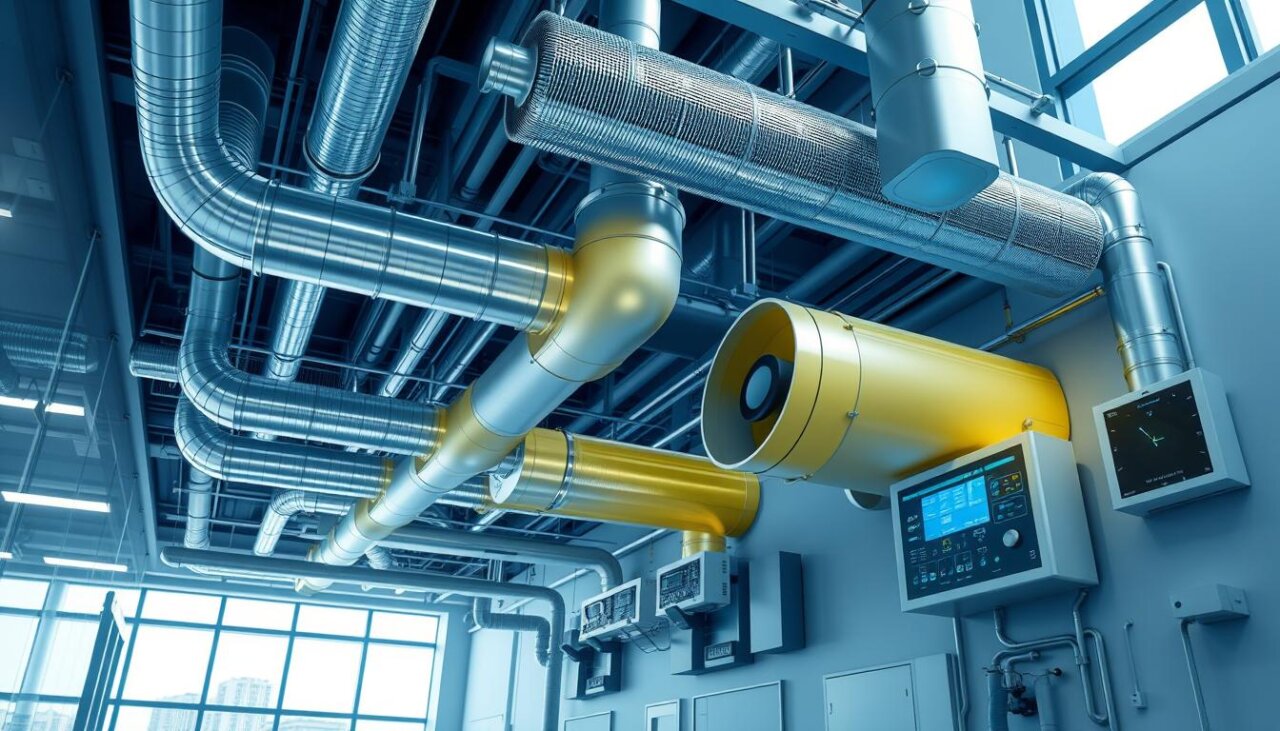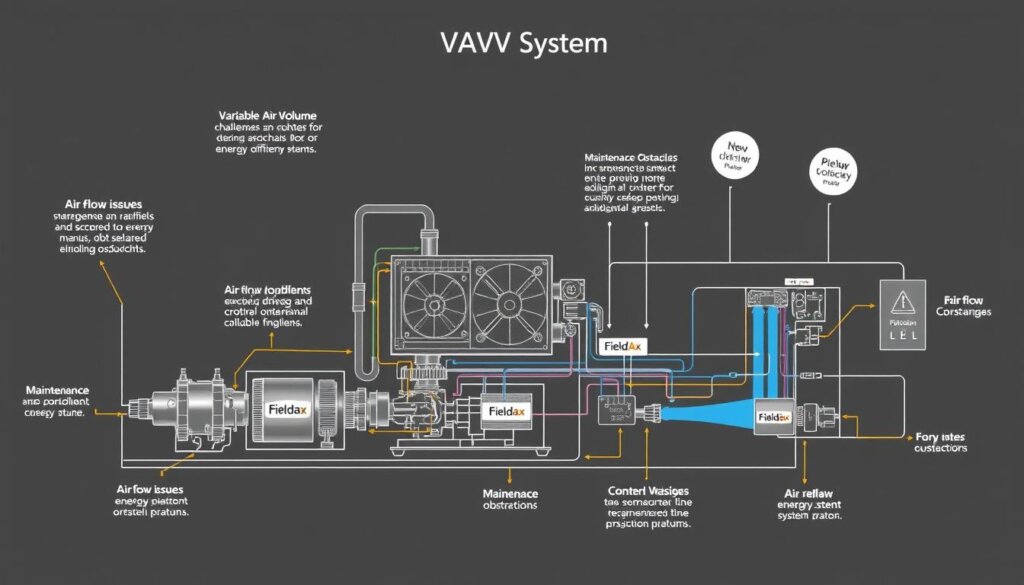Imagine walking into a large conference room, expecting a refreshing breeze but finding stagnant air instead. Now, imagine walking into the same room and feeling the air is perfectly tempered. This isn’t luck; it’s the Variable Air Volume (VAV) system at work.
Over my time in HVAC management, I’ve seen how VAV systems change spaces. They optimize air distribution and save energy. These systems cut down on energy bills and make clients happier and more comfortable.
Before buying, it’s key to understand VAV systems. You need to know how to size them right and how HVAC service software can help. In this guide, I’ll explain what VAV systems are, their parts, and their benefits. This way, you’ll know what to choose, whether you’re an HVAC expert or just starting out.

Key Takeaways
- VAV systems enhance energy efficiency compared to traditional CAV systems.
- Implementing VAV systems can lead to reduced utility costs for businesses.
- These systems provide customized temperature control, resulting in higher client satisfaction.
- Proper sizing is essential for optimal system performance and longevity.
- Flexibility for future expansions makes VAV systems a scalable investment.
- Using HVAC service software can enhance VAV system functionality through data analytics.
What is VAV and Why Is It Important?
Knowing what VAV is key to understanding its role in today’s HVAC systems. Variable Air Volume (VAV) systems adjust airflow in different zones. This is based on the need for specific temperatures, making them crucial for efficient air systems.
The importance of VAV comes from its ability to change airflow as needed. This flexibility helps systems adjust to changes in people and weather. It leads to better HVAC efficiency by using less energy while keeping everyone comfortable.
VAV systems help manage energy by reducing waste. They allow for exact temperature control, making spaces more comfortable and saving money. As we focus on making buildings more sustainable, VAV’s role becomes even more important. Switching to VAV technology is a step towards better efficiency and caring for the environment.
Components of a VAV System
Exploring a VAV system means understanding its key parts. At the heart, VAV boxes control airflow to different areas. They let people adjust temperature and air flow, making spaces comfortable.
Dampers manage air flow in the duct system. They work with VAV boxes to control air distribution. Control systems, like the brain, coordinate air flow based on feedback from sensors and thermostats.
Actuators adjust air flow based on real-time data. This teamwork makes the system efficient, saving energy. Air distribution parts, like ductwork, help air reach each room.
These components work together to meet changing needs while keeping spaces comfortable. Knowing about these parts is key for setting up a VAV system.
Benefits of Using VAV Systems
Variable Air Volume (VAV) systems bring many advantages. They improve energy efficiency by adjusting airflow to meet zone needs. This reduces energy use, making them more efficient than traditional systems.
VAV systems also enhance indoor air quality. They use MERV-8 and optional MERV-13 filters to keep the air clean. This makes the environment healthier for everyone. Plus, they minimize noise, ensuring a comfortable space.
Cost-effectiveness is another key benefit. VAV systems with Air-Fi® Wireless Communication make setup easier and cheaper. Their compact design fits well in different spaces, saving on installation costs.
Using VAV systems can save money in the long run. They use advanced technologies like AI to improve efficiency. This shows how VAV systems are changing HVAC design for better cost and comfort.
Choosing the Right VAV System for Your Needs
Choosing VAV systems requires careful thought about several factors. It’s important to know the VAV system types available. These systems adjust airflow based on real-time demand, making them more efficient than traditional systems.
Understanding the size and layout of your building is crucial. These factors greatly affect the effectiveness of different HVAC solutions.
The intended use of your spaces is also key. Commercial spaces might need different custom VAV options than residential homes. It’s vital to choose a system that meets your energy goals to save money in the long run.
Opting for custom VAV options allows for specific temperature control. This increases client satisfaction with tailored solutions.
Proper sizing and load calculations are essential for the system’s performance. Balancing airflow and pressure in the ducts ensures consistent temperatures in each zone. An appropriate layout and strategic thermostat placement boost energy efficiency and lower maintenance costs.
Understanding HVAC Service Software
HVAC service software is key for better VAV system performance. It helps streamline operations and boosts efficiency. This tech is crucial for HVAC system upkeep, offering real-time monitoring and predictive maintenance.
It also comes with scheduling tools. This software simplifies VAV system management and increases efficiency.
How HVAC Service Software Can Enhance Your VAV System
Using HVAC service software can greatly improve your VAV system’s performance. It allows for real-time monitoring, helping make quick adjustments to airflow and energy use. Predictive maintenance analytics spot issues early, reducing downtime and repair costs.
These tools offer insights to enhance system performance and keep environments comfortable.
Top Features to Look for in HVAC Service Software
When picking HVAC service software, look for key features that meet your needs. A user-friendly interface makes it easy for technicians to use. Robust reporting gives valuable insights into system performance.
Scheduling tools are crucial for managing jobs efficiently, ensuring timely maintenance and service calls. Choosing software with these features can greatly improve workflow and customer satisfaction.
Common Challenges When Implementing VAV
Setting up VAV systems can be tricky. Issues like high initial costs, complex controls, and uneven airflow can cause problems. Knowing these challenges helps me plan better for a successful start.

Addressing User Experience Concerns
Improving the HVAC user experience is key. Training staff on the system can help with airflow issues. It’s also important to explain how the system works and its benefits.
VAV systems offer tailored temperature control, boosting comfort and satisfaction. By focusing on energy savings and comfort, we can overcome many implementation issues. This makes the transition to VAV smoother.
Cost Considerations for VAV Systems
When I look at VAV system costs, I consider both the initial cost and long-term savings. The initial investment in VAV can be high, especially for retrofitting. Building owners need to set aside a good budget for HVAC systems for installation, testing, and upgrades.
Looking at VAV pricing isn’t just about the initial cost. A well-designed VAV system can save a lot of energy over time. This makes it a smart investment in VAV. Plus, it can lead to lower utility bills, which helps in getting a good return on investment.
When planning for these costs, using platforms like SmartAC.com is helpful. They offer subscription options that help keep costs down. In the end, it’s important to weigh both costs and savings to make the right choice for VAV systems.
Integration with Existing HVAC Systems
Integrating VAV systems into existing HVAC setups is both a challenge and an opportunity. It’s important to see if VAV technology works well with older heating and cooling systems. This ensures the new system works well with what’s already there, making everything more efficient.
Importance of HVAC Field Service Management Software
Using HVAC field service management software makes integration easier. It helps with scheduling, tracking maintenance, and quick service. With the right software, I can keep an eye on how systems are doing and handle maintenance requests smoothly.
Features like automatic alerts and updates help reduce downtime. This means services can run smoothly and efficiently. It’s all about using technology to make new and old systems work together seamlessly.
Conclusion
In this summary of VAV systems, I’ve covered the main points. VAV systems are key to modern HVAC solutions. They save energy and improve air quality, which is great for homes and businesses.
Using HVAC service software boosts these benefits. It makes operations smoother and helps manage systems better.
Reflecting on HVAC service software, it’s clear these tools are vital. They help keep VAV systems running well. This leads to longer system life and better performance.
The future of VAV technology looks bright. New innovations are changing how we handle heating, ventilation, and air conditioning.
Looking forward, I see trends like more automation and real-time data. These changes will make our HVAC systems more efficient and user-friendly. Staying updated on these trends is key to meeting our HVAC needs.
See how FieldAx can transform your Field Operations.
Try it today! Book Demo
You are one click away from your customized FieldAx Demo!
FAQ
What is a Variable Air Volume (VAV) system?
A Variable Air Volume (VAV) system adjusts airflow in different zones. It does this based on temperature control needs. This makes buildings more energy-efficient and comfortable.
Why is it important to understand VAV systems?
Knowing about VAV systems helps improve air distribution and comfort. It also boosts energy efficiency and system performance in HVAC.
What are the primary components of a VAV system?
A VAV system has VAV boxes, dampers, control systems, sensors, and actuators. These parts work together to control airflow efficiently in various spaces.
What are the benefits of using VAV systems?
VAV systems offer better energy efficiency and air quality. They also control comfort and reduce costs by delivering just the right amount of air.
How do I choose the right VAV system for my building?
Consider your building’s size, layout, and use when choosing a VAV system. Look at different types and customization options for the best fit.
What is HVAC service software?
HVAC service software helps manage HVAC systems digitally. It includes features like real-time monitoring and maintenance analytics. This improves HVAC system performance, including VAV technology.
What are the key features to look for in HVAC service software?
Look for user-friendly interfaces and robust reporting in HVAC service software. Real-time data analytics and preventive maintenance tools are also important. They help make VAV systems more effective.
What common challenges are faced during VAV system implementation?
Challenges include high initial costs and complex control systems. Airflow fluctuations can also cause discomfort. Proper training and communication can help solve these issues.
What are the cost considerations when adapting VAV systems?
Costs include initial installation and long-term energy savings. The potential return on investment is also key. These factors help make informed decisions about HVAC upgrades.
How can VAV systems be integrated into existing HVAC setups?
VAV systems can be added to existing HVAC setups by checking compatibility. Using HVAC field service management software helps ensure a smooth transition. This maximizes the benefits of VAV systems.
Author Bio
Co-Founder & CMO at Merfantz Technologies Pvt Ltd | Marketing Manager for FieldAx Field Service Software | Salesforce All-Star Ranger and Community Contributor | Salesforce Content Creation for Knowledge Sharing






